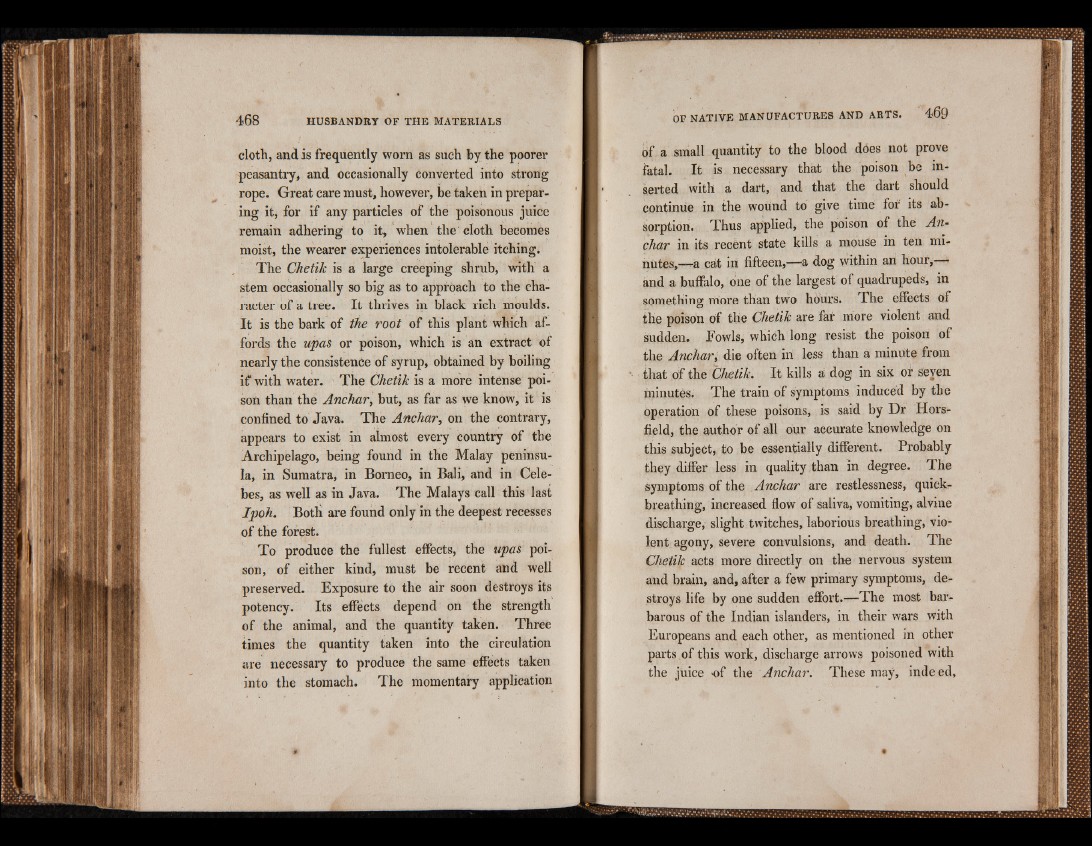
cloth, and is frequently worn as such by the poorer
^peasantry, and occasionally converted into strong
rope. Great care must, however, be taken in preparing
it, for if any particles of the poisonous juice
remain adhering to it, when the' cloth becomes
moist, the wearer experiences intolerable itching.
The Chetilc is a large creeping shrub, with a
stem occasionally so big as to approach to the character
of a tree. It thrives in black rich moulds.
It is the bark of the root of this plant which affords
the upas or poison, which is an extract of
nearly the consistence of syrup, obtained by boiling
it* with water. The Chetik is a more intense poison
than the Anchar, but, as far as we know, it is
confined to Java. The Anchar, on the contrary,
appears to exist in almost every country of the
Archipelago, being found in the Malay peninsula,
in Sumatra, in Borneo, in Bali, and in Celebes,
as well as in Java. The Malays call this last
Ipoh. Both are found only in the deepest recesses
of the forest.
To produce the fullest effects, the upas poison,
of either kind, must be recent and well
preserved. Exposure to the air soon destroys its
potency. Its effects depend on the strength
of the animal, and the quantity taken. Three
times the quantity taken into the circulation
are necessary to produce the same effects taken
into the stomach. The momentary application
bf a small quantity to the blood does not prove
fatal. It is necessary that the poison be inserted
with à dart, and that the dart should
continue in the woünd to give time for its absorption.
Thus applied, the poison of the Anchar
in its recènt state kills a mouse in ten minutes,—
a cat in fifteen,—a dog within an hour,—
and a buffalo, one of the largest of quadrupeds, in
something more than two hours. The effects of
the poison of the Chetik are far more violent and
sudden. Fowls, which long resist the poison of
the Anchar, die often in less than a minute from
that of the Chetik. It kills a dog in six of seven
minutes. The train of symptoms induced by the
operation of these poisons, is said by Df Hors-
field, the author of all bur accurate knowledge on
this subject, to be essentially different. Probably
they differ less in quality than in degree. The
symptoms of the Anchar are restlessness, quick-
breathing, increased flow of saliva, vomiting, alvine
discharge, slight twitches, laborious breathing, violent
agony, severe convulsions, and death. The
Chetik acts more directly on the nervous system
and brain, and, after a few primary symptoms, destroys
life by one sudden effort.—The most barbarous
of the Indian islanders, in their wars with
Europeans and each other, as mentioned in other
parts of this work, discharge arrows poisoned with
the juice of the Anchar. These may, indeed,